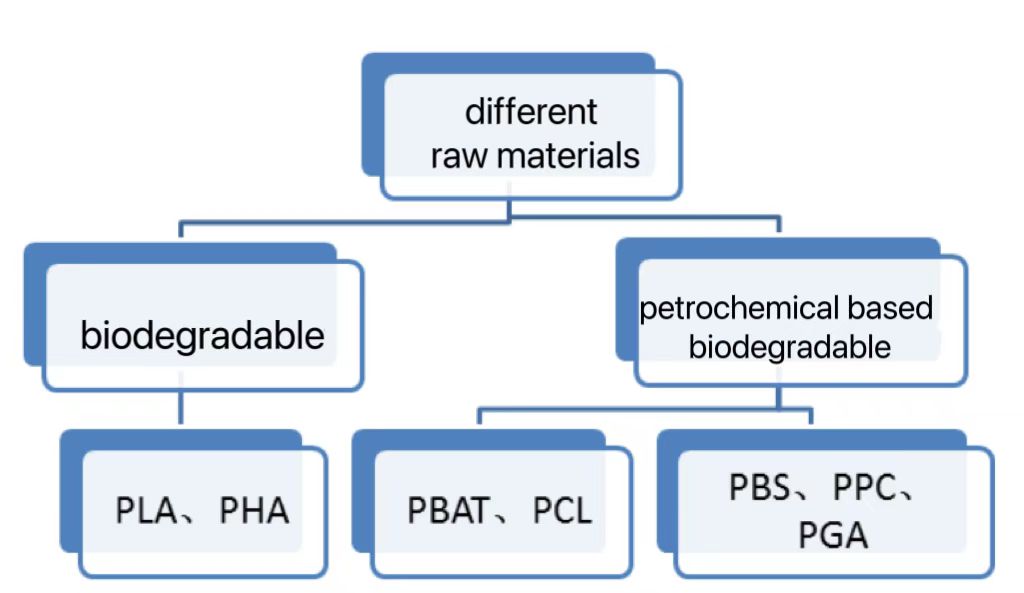According to different manufacturing processes, biodegradable plastics are divided into microbially synthesized degradable plastics, chemically synthesized price-reduced plastics, and natural polymer blended degradable plastics; according to different sources of raw materials, they are divided into bio-based biodegradable plastics and petrochemical-based biodegradable plastics.
Among them, bio-based degradable plastics include polylactic acid (PLA), polyhydroxyalkanoate (PHA), etc.; petrochemical-based biodegradable plastics refer to plastics obtained by polymerizing petrochemical product monomers by chemical synthesis methods, such as polyparaphenylene Dicarboxylic acid-butylene adipate (PBAT), polycaprolactone (PCL), polybutylene succinate (PBS), carbon dioxide copolymer (PPC), polyglycolic acid (PGA), etc.

(1) Bio-based degradable plastics
PLA has reliable biological safety, biodegradability, good mechanical properties and easy processing. The disadvantage is that the degradation conditions are relatively harsh, but because PLA has a relatively low cost in biodegradable plastics, its consumption is at the forefront. PLA can be widely used in packaging, textile and other industries.
PHA has good biodegradability and biocompatibility, and its melting point and strength are higher than LDPE, but its production cost is too high, which can reach 60,000-70,000 yuan/ton, so its commercialization degree is currently low, and The degradation rate of PHA is too fast, resulting in poor storage stability. PHA can be applied to high-end biomedical materials, such as surgical sutures and drug carriers.

(2) Petroleum-based degradable plastics
PBAT has good ductility and elongation at break. However, its water vapor barrier and oxygen barrier properties are poor. PBAT can be used in the packaging of tableware, cosmetic bottles and pharmaceutical bottles, disposable medical supplies, agricultural films, pesticide and fertilizer slow-release materials.
The melting point of PCL is only 60°C, the upper limit temperature of use is low, and its price is relatively high, which is 40,000-45,000 yuan/ton, and its degradation rate is also slow. Therefore, its scope of application is very limited, and its degree of industrialization is relatively low. Currently, it can be used in high-end biomedical materials and other fields.
PBS has good biocompatibility and bioabsorbability, and good heat resistance. PBS can be used in packaging films, tableware, foam packaging materials, daily necessities bottles, medicine bottles, agricultural films, pesticide and fertilizer slow-release materials and other fields.
PPC has high water vapor barrier and oxygen barrier properties. It has good tensile, bending, compression and impact resistance. It can be used alone as a structural material, as an oxygen barrier material, surfactant, ceramic adhesive, Hot melt adhesive, etc.
The melting point and strength of PGA are higher than that of LDPE, but the tensile toughness is lower than that of LDPE. Compared with PLA, PGA has very excellent strength and gas barrier properties, and it has high application potential in the field of high-performance plastics, such as high gas barrier packaging. materials and engineering plastics.
At present, the two largest degradable plastics are PLA and PBS/PBAT, and they are highly recognized in the market. They are most likely to replace non-degradable plastics on a large scale and be used in the field of disposable plastic products.
As for PHA and PGA, the current production cost is too high, the degree of commercialization is low, and the degradation rate is too fast, and the storage stability is poor. However, considering that they have their own unique properties, and the cost is expected to decrease in the future, their development prospects remain to be investigated.
The existing production capacity and the expected increase in future production capacity of degradable plastics such as PPC and PCL are relatively small. It cannot compete with PLA and PBS/PBAT in replacing general-purpose plastics, but is mostly used in the field of high-end biomedical materials.











